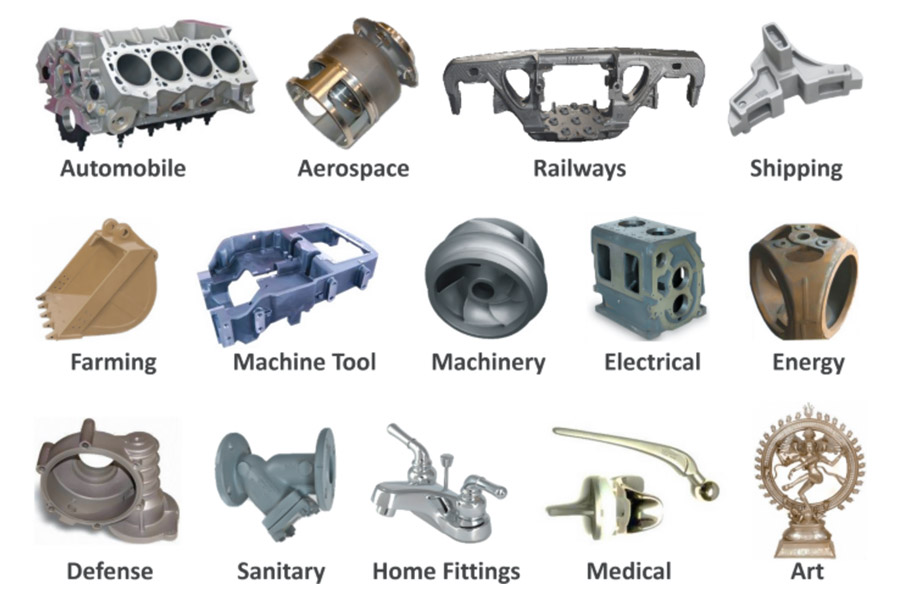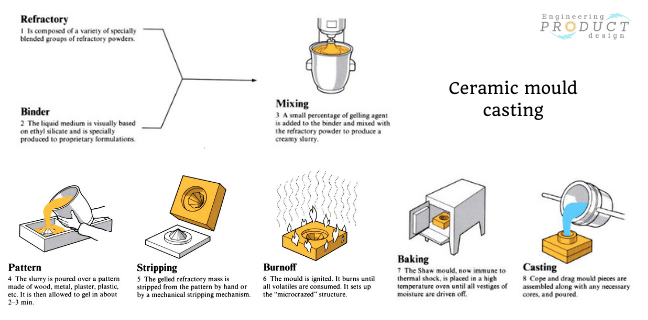Discover the modern world of Aluminum Castings and their unique industrial applications
Wiki Article
Comprehending the Steel Castings Process: A Comprehensive Guide for Beginners
The Metal Casting procedure is an essential strategy in producing that transforms molten steel right into solid forms. Beginners have to realize the different techniques involved, such as sand spreading and die spreading. Understanding the materials, design concepts, and precaution is equally vital. Each aspect plays a vital duty in accomplishing successful outcomes. As one navigates these details, the inquiry of just how to maximize each step for enhanced outcomes becomes increasingly pertinent.The Basics of Steel Casting
Metal Casting has actually progressed over centuries, its essential concepts remain important and regular to the manufacturing procedure. At its core, Metal Casting entails the improvement of molten steel into strong objects via different techniques. The procedure starts with the creation of a mold, which specifies the form of the final product. As soon as the mold and mildew is prepared, metal is warmed to its melting point and put right into the dental caries. After cooling down, the steel solidifies, taking the form of the mold.There are numerous casting techniques, including sand casting, financial investment casting, and pass away spreading, each with distinct advantages and applications. The option of method depends upon elements such as production quantity, product kind, and wanted precision. When cast, the final product might undergo additional procedures like machining or surface area treatment to attain the called for finish and specifications. Recognizing these fundamentals is essential for anyone curious about the area of Metal Casting.

Understanding Products Made Use Of in Metal Casting
Materials play an important duty in the Metal Casting procedure, affecting the end product's residential or commercial properties and performance. Various steels are made use of, including aluminum, steel, bronze, and iron, each offering distinctive qualities matched for particular applications. Aluminum is corrosion-resistant and light-weight, making it optimal for vehicle components. Iron, particularly cast iron, is preferred for its exceptional wear resistance and toughness. Steel provides high toughness and convenience, frequently made use of in hefty equipment components. Bronze, known for its rust resistance and machinability, is commonly used in aquatic applications.Along with the metals, different casting materials, such as sand, plaster, and ceramic, are utilized to create molds. Sand casting, one of the most prevalent approach, utilizes silica sand due to its thermal security and ability to create intricate shapes. Plaster and ceramic molds use better details however may call for more intricate processes. The option of materials straight affects the effectiveness, cost, and top quality of the spreading procedure.
The Layout Process: From Idea to Plan
The design procedure in Metal Casting starts with the preliminary idea development, where concepts are generated and examined. This is complied with by the application of CAD modeling methods, enabling for exact visualizations of the design. Finally, the plan finalization steps assure that all requirements are accurately documented for manufacturing.Preliminary Principle Advancement
Initial concept development marks an important stage in the Metal Casting process, where concepts change into tangible designs. Throughout this phase, developers work together with engineers and stakeholders to brainstorm and fine-tune preliminary concepts. They consider elements such as capability, aesthetic appeals, and manufacturability, making certain that the layout meets the called for requirements and performance standards. Illustrations and harsh drafts are produced to imagine the concepts, enabling initial assessments of expediency and cost-effectiveness. This phase likewise entails recognizing products and prospective casting approaches that straighten with the design objectives. Ultimately, first concept development lays the foundation for a thorough plan, guiding the subsequent stages of the spreading process and guaranteeing a successful change from concept to truth.CAD Modeling Techniques
Transforming concepts into exact layouts, CAD modeling strategies play a critical duty in the Metal Casting process. These methods use advanced software program to produce comprehensive three-dimensional models that properly show the designated item. By using tools such as parametric modeling, strong modeling, and surface modeling, designers can control measurements and shapes effortlessly. CAD systems additionally facilitate simulation and analysis, permitting the identification of prospective problems before manufacturing starts. This aggressive approach lowers material waste and enhances the design for manufacturability. Furthermore, CAD models can be quickly changed, enabling quick models based upon feedback. Fundamentally, CAD modeling works as the foundation of the layout procedure, bridging the space between initial concepts and the ultimate production-ready designs.Blueprint Finalization Tips
Adhering to the development of thorough CAD models, the following stage includes plan completion, which is vital in translating electronic styles right into actionable plans for manufacturing. This process begins with assessing the CAD versions for accuracy and compliance with specifications. Once validated, the dimensions, resistances, and material specifications are meticulously detailed to guarantee clearness. Including comments and notes assists interact vital info relating to casting procedures, surface area coatings, and setting up requirements. The finalized blueprint undertakes a rigorous approval procedure, usually including partnership with engineers and production teams to attend to any kind of possible problems. Besides revisions are made and authorizations gotten, the blueprint is officially launched, functioning as the fundamental document for the subsequent stages of Metal Casting, including pattern production and mold and mildew style.The Metal Casting Methods Explained

Metal Casting methods incorporate a range of techniques utilized to form liquified steel into desired types. These techniques differ according to the kind of product, intricacy of the design, and manufacturing volume. Sand spreading is one of one of the most usual techniques, involving the production of a mold and mildew from sand to hold the molten steel. Financial investment spreading, or lost-wax spreading, permits elaborate layouts by utilizing a wax pattern that is dissolved. Die casting uses high-pressure injection of molten metal right into a mold, ideal for automation. Various other methods include irreversible mold casting, discover here which makes use of reusable molds, and centrifugal casting, where rotational pressures assist in filling the mold and mildew. Each strategy has its benefits and applications, making it vital for producers to select the ideal technique based upon their particular demands and requirements. Comprehending these methods is crucial for anybody associated with the Metal Casting process.
Ending Up Processes: Enhancing Your Casted Product

Ending up processes play a necessary role in improving the quality and look of casted products. Numerous surface therapy strategies, such as polishing and coating, are employed to enhance resilience and looks. In addition, high quality assessment methods assure that the end product fulfills defined standards and efficiency needs.
Surface Area Therapy Strategies
A selection of surface area treatment strategies play an essential duty in improving the quality and long life of casted items. These methods consist of techniques such as shot blasting, polishing, and coating. Shot blasting effectively eliminates surface blemishes, improving the visual and functional characteristics of the spreading. Polishing offers a smooth coating, which is especially important for attractive applications and elements needing very little rubbing. Finishing methods, such as electroplating or powder finish, deal additional protection against corrosion and wear, making certain sturdiness. Surface therapies can boost bond for subsequent procedures, such as paint or bonding. By employing these techniques, producers can attain remarkable surface area top quality, which is vital for the efficiency and life-span of Metal Casting in different applications.Top Quality Examination Methods
Efficient top quality examination techniques are important for assuring the integrity and efficiency of casted products after the ending up processes. Numerous strategies are employed to evaluate the quality of Metal Casting, including visual assessment, dimensional checks, and non-destructive testing (NDT) Visual examination permits for the recognition of surface area defects, while dimensional checks ensure that products meet defined tolerances. NDT approaches, such as ultrasonic screening and radiographic evaluation, give deeper understandings right into internal honesty without harming the castings. Additionally, mechanical testing, such as tensile and firmness examinations, examines material properties - Aluminum Castings. By employing a mix of these methods, producers can boost item top quality and dependability, eventually bring about higher customer satisfaction and minimized production costsSafety And Security Considerations in Metal Casting
While the Metal Casting procedure provides numerous advantages, it also provides a series of security dangers that need to be carefully handled. Employees in casting centers are exposed to high temperature levels, molten metals, and hazardous materials, which can bring about serious injuries if correct safety measures are not taken. Individual protective devices (PPE) such as heat-resistant handwear covers, encounter shields, and protective apparel is vital to decrease dangers.Furthermore, the visibility of fumes and dirt requires proper air flow systems to assure air quality - Aluminum Castings. Routine training on safety protocols is important for all employees to recognize possible dangers and react properly. Emergency situation treatments ought to be established, consisting of fire security procedures and first help accessibility. Maintenance of equipment and correct handling of products further add to a much safer working setting. By focusing on these security considerations, Metal Casting procedures can shield their labor force and maintain efficient production processes
Regularly Asked Questions
What Are the Environmental Impacts of Metal Casting?
Metal Casting can result in environmental impacts such as air and water contamination, resource exhaustion, and energy usage. Furthermore, incorrect waste administration and discharges from shops add to eco-friendly here are the findings disturbances and wellness threats for neighboring areas.Just how Do I Select the Right Steel for Spreading?
To select the best steel for spreading, one have to take into consideration elements such as mechanical homes, rust resistance, thermal conductivity, and cost. Evaluating the intended application and ecological problems is important for excellent choice.What Are the Typical Flaws in Metal Casting?
Typical problems in Metal Casting include porosity, contraction, sand addition, and misruns. These issues often develop from improper material option, inadequate design, or anchor imperfections in the spreading process, impacting the end product's top quality and performance.
Exactly How Can I Enhance My Steel Casting Skills?
To boost Metal Casting abilities, one ought to practice regularly, research study casting methods, examine previous projects for defects, look for responses from knowledgeable casters, and continually try out different products and techniques to improve proficiency and understanding.What Is the Cost of Starting a Metal Spreading Organization?
Starting a steel spreading business commonly calls for a first investment of $5,000 to $50,000, depending upon devices, products, and center expenses. Aspects like area and range can greatly influence total startup costs.The Metal Casting process is a basic technique in producing that transforms molten metal into solid kinds. Newbies should realize the numerous methods involved, such as sand casting and pass away casting. There are a number of casting methods, including sand spreading, investment spreading, and pass away casting, each with special benefits and applications. Investment casting, or lost-wax spreading, permits for intricate styles by using a wax pattern that is melted away. Various other techniques include irreversible mold and mildew spreading, which uses recyclable mold and mildews, and centrifugal spreading, where rotational pressures aid in filling up the mold.
Report this wiki page